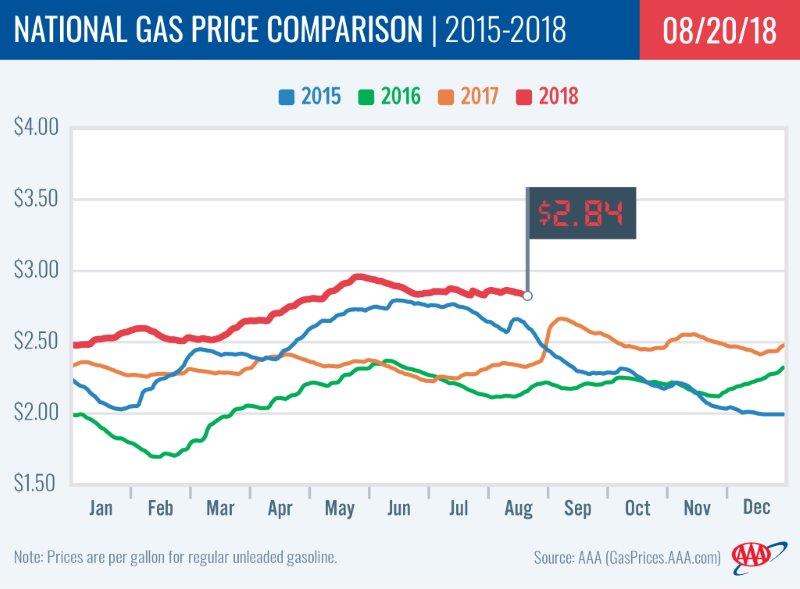PORTLAND, Ore., – Retail gas prices are slowly moving lower as the summer driving season tapers off. Drivers in most states including Oregon are seeing small decreases at the pumps. For the week, the national average for regular loses three cents to $2.83 while Oregon’s average dips two cents to $3.25.
Prices have backed away from their year-to-date highs. The national average reached $2.97 in late May, while the Oregon average remained at $3.35 in late May through early June.
“Consumer demand for gasoline is lower now than in July, putting downward pressure on prices. They should continue to fall in the coming weeks, barring unforeseen events, especially with the switchover to winter-blend fuel in September. However, we could see temporary price hikes around Labor Day as folks squeeze in a final summer getaway,” says Marie Dodds, public affairs director for AAA Oregon/Idaho.
In September, gas stations will start selling winter-blend gasoline. This blend, which is cheaper to produce, contains a fuel that evaporates at low temperatures for vehicle engines to operate properly, especially when the engine is cold.
Oregon is one of 46 states and the District of Columbia where prices are lower now than a week ago. The largest decreases are in Michigan (-11 cents) and Illinois (-7 cents). The largest weekly increase is in Utah (+6 cents). The average in Hawaii is flat. This week 10 states and the District of Columbia have averages at or above $3 a gallon, compared to 11 states and D.C. a week ago.
Oregon is one of 40 states and the District of Columbia where prices are lower than one month ago. The national average is two cents less and the Oregon average is five cents less than a month ago. Oregon has the sixth-largest monthly decrease in the country. Arizona (-7 cents) has the largest monthly decrease, while Idaho (+12 cents) has the largest monthly increase.
The West Coast continues to have the most expensive gas prices in the nation. Hawaii tops the list for the 11th week in a row with California, Washington, Alaska, Oregon, Idaho and Nevada rounding out the top seven. Oregon is fifth for the ninth consecutive week.
When compared to last week, most pump prices in the West Coast region are down. Alaska and Oregon have the largest drops (-2 cents). Hawaii’s average is flat.
According to the Energy Information Administration’s (EIA) petroleum status report for the week ending on August 10, inventories of gasoline in the region fell by 100,000 bbl. They now sit at 30.3 million bbl, which is nearly four million bbl lower than total levels at this time last year. Slowing demand has reduced stocks slightly in the region, but as supplies tighten, any supply shocks could make the market more volatile this week and prices could spike.
The nation’s cheapest markets are South Carolina ($2.53) Alabama ($2.54) and. For the 55th week in a row, no states have an average below $2.
Drivers in all 50 states and the District of Columbia are paying more than a year ago to fill up. The national average is 50 cents more and the Oregon average is 44 cents more than a year ago. This is the 47th-largest yearly increase in the country. Hawaii (+69 cents) has the greatest year-over-year increase; Arizona (+62 cents) is second; California (+61 cents) is third; Utah (+60 cents) is fourth; and Connecticut (+58 cents) is fifth.
Oil Market Dynamics
Crude oil prices ended last week and started this week with gains, due in part to a softening dollar. Crude prices tumbled midweek last week after new data from the EIA showed domestic crude oil inventories grew by 6.8 million bbl last week. The unusually high growth in crude inventories caught market observers by surprise, raising concerns that summer demand may be waning. At 414.2 million bbl, crude inventories in the U.S. are about 52 million bbl lower than they were at this point last summer, which has contributed to higher gas prices this summer. Domestic crude production topping 10.9 million b/d and imports surging to just over 9 million b/d gave total crude inventories their boost last week. If these trends continue into this week, crude inventories may show more growth, which would likely push domestic crude prices lower.
In related news, according to Baker Hughes, Inc., the U.S. added no oil rigs last week, leaving the total unchanged at 869. Currently, there are 106 more active rigs this year than last year at this time.
At the close of Friday’s formal trading session on the NYMEX, WTI increased 45 cents to settle at $65.91. At the close of Monday’s formal trading session on the NYMEX, WTI gained 52 cents to settle at $66.53. Today crude is trading around $67, same as a week ago. Crude prices are down about three percent in the last month and are about $18 more per barrel than a year ago.
Drivers can find current gas prices along their route with the free AAA Mobile app for iPhone, iPad and Android. The app can also be used to map a route, find discounts, book a hotel and access AAA roadside assistance. Learn more at AAA.com/mobile.
Diesel
For the week, the national average slips a penny to $3.14 a gallon. Oregon’s average remains at $3.39. A year ago the national average for diesel was $2.53 and the Oregon average was $2.77.
Find current fuel prices at GasPrices.AAA.com.
AAA news releases, high resolution images, broadcast-quality video, fact sheets and podcasts are available on the AAA NewsRoom at NewsRoom.AAA.com.



